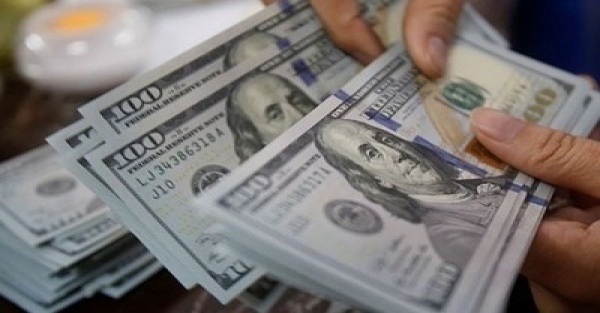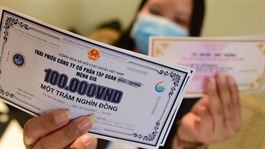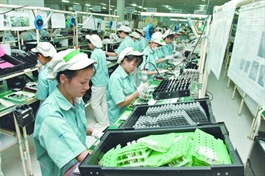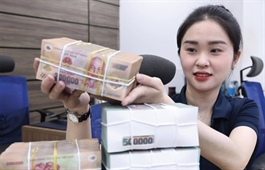Exchange rate volatility looms as year-end risks mount
Exchange rate volatility looms as year-end risks mount
Exchange rates face mounting pressure amid domestic and global headwinds, challenging policymakers to maintain macroeconomic stability while navigating growth objectives and diverging monetary policies among major economies
After a sharp rise of approximately 2 per cent in April, the USD-VND exchange rate showed more volatile behaviour in May.
It dropped by about 50 points in the first half of the month and rebounded by 80 points in the latter half. Overall, exchange rate volatility in May fell significantly, by around 75-80 per cent compared to the previous two months.
In a talk with VIR, a senior executive at major state lender BIDV noted that, compared to other currencies, the VND has demonstrated greater stability, depreciating only about 0.1 per cent against the US dollar. In contrast, most other currencies saw fluctuations of more than 1 per cent either way during May.
|
Internationally, the USD’s downward momentum slowed in May, trading primarily within a range of 98–102 on the DXY index. Supporting this stability was a cooling in trade tensions, as the US and China agreed to roll back tariffs significantly for 90 days.
Soft economic data in the US also showed signs of improvement as consumer sentiment rose from 86 to 98, the Purchasing Managers' Index increased from 50.6 to 52.1, and core inflation eased from 2.4 per cent to 2.3 per cent on-year.
"However, the USD has yet to regain momentum due to mounting concerns over the US fiscal outlook," the BIDV executive said. "The tax cut bill recently passed by the House of Representatives is expected to add around $3 trillion to the US budget deficit, keeping the deficit-to-GDP ratio at a minimum of 6 per cent for the next decade."
Domestically, the BIDV executive highlighted that the foreign currency supply-demand balance shifted into a deficit of around $300–500 million, largely due to cyclical increases in imports and the State Treasury’s foreign debt repayments.
Nonetheless, this deficit was less severe than anticipated thanks to continued export growth and sustained positive foreign direct investment (FDI) disbursement, which surpassed $2 billion in May.
Analysts predict that in June, the exchange rate will continue to fluctuate within a narrow range. However, the risk of greater volatility is rising as negotiations near their conclusion.
Looking ahead to the international environment, BIDV’s senior leadership forecasts that the DXY index, which measures the USD strength, will likely remain within the 98-101 range.
On one hand, downward pressure on the USD may intensify amid renewed US-China tensions, which flared again in late May.
Recent aggressive moves by President Trump – such as threatening to raise tariffs on the EU by 50 per cent, imposing a 25 per cent tariff on Apple products made outside the US, and doubling tariffs on aluminium and steel from 25 per cent to 50 per cent – have added to the uncertainty.
Persistent concerns over the US fiscal deficit also pose challenges for the USD, reflected in the yield on 30-year US Treasury bonds, which is approaching a 5 per cent annual peak.
Conversely, some factors could provide support for the greenback. US GDP growth in Q2 is projected to reach 3.8 per cent, a strong rebound from the -0.3 per cent contraction in Q1, as pre-tariff import activity tapers off.
Domestically, the foreign currency supply-demand situation is expected to improve in June. This would be driven by a seasonal decrease in import demand following its May peak, and a potential uptick in FDI disbursement, in line with cyclical trends.
"However, foreign currency supply may still remain relatively constrained, as the State Treasury continues to increase demand for foreign currency to service its external debt," said the BIDV executive.
Analysts also warn that the boost from exports may diminish, given signs of weakening US import demand in April. Furthermore, market sentiment appears more cautious amid ongoing challenges in US-Vietnam trade negotiations and a persistently low VND-USD interest rate spread.
In a talk with VIR, Pham Hong Hai, CEO of southern lender OCB, remarked that the central bank (SBV) is currently in an exceptionally challenging position. On one hand, it must safeguard macroeconomic stability; on the other, it is expected to support economic growth.
"Monetary policy now faces a new dilemma as the US Federal Reserve finds itself constrained in cutting interest rates, while Vietnam and other emerging markets continue to pursue an accommodative monetary stance," Hai explained. "This divergence is placing increasing pressure on the VND exchange rate."
Adding to the concern, Tran Thi Khanh Hien, head of Research at MB Securities, remarked that although the US dollar remains relatively weak globally, the USD-VND rate has already breached the 26,000 threshold, rising nearly 2 per cent since the start of the year.
"This signals a significant risk as we look towards the end of 2025," said Hien.
In a related development, SBV Governor Nguyen Thi Hong noted that credit growth and interest rates remain core issues for both businesses and the public across multiple economic cycles.
"Beyond managing lending activities of credit institutions, the SBV’s critical mandate is to steer monetary policy in a way that helps control inflation, maintain macroeconomic stability, and ensure orderly financial and foreign exchange markets," said Hong. "This is an extremely complex and high-pressure task, particularly given Vietnam’s deeply open and unpredictable economy."
Looking ahead, Hong reaffirmed the SBV’s commitment to closely monitoring market developments, saying "The central bank will calibrate its tools and policy responses carefully, both in timing and intensity, especially in balancing the trade-off between exchange rate stability and the goal of lowering interest rates."
Hong gave the remark at the dialogue meeting between the Prime Minister and the business community on May 31 in Hanoi, aimed at effectively implementing Resolution 68-NQ/TW of the Politburo on encouraging private sector development.
- 19:38 09/06/2025





























